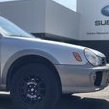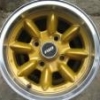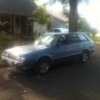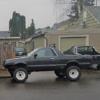Search the Community
Showing results for tags 'vacuum'.
-
I've searched through the forums looking for info on how to solve my issue but nothing I have found has helped. I'm hoping that you guys might be able to. So after an afternoon out on some rough trails, my soobs vent doors to switch from vent to defrost to bi-level have stopped switching, I only have air coming through the main vents. At the same time i also only have speeds 3 and 4, when I have it set to 1 or 2 the blower isn't on whatsoever. I've checked the vacuum lines in the engine bay and directly behind the switches and all seem to be intact. Does anyome have any tips as to where I can search next? Thanks in advance!
-
After searching for almost a year, my fiance and I got this car in the spring of 2016 for her to use as a commuter during bad snow days. Shortly after purchasing it, we took it to a local mechanic to have it inspected and to address any glaring issues. We ended up putting in new wheel bearings, suspension, flywheel, clutch, axle shaft assembly, and several other things. Before the mechanic was done working on the car, it was stolen off of his lot (left unlocked with keys in the ignition). The kid who stole it couldn't drive a stick and blew the engine about a mile up the road. Other than the blown engine, no other apparent damage was done. They ended up catching the kid who stole it and he was ordered to reimburse the mechanic for the damages. The prosecutor told me the mechanic was responsible for replacing the blown motor. Fast forward more than a year - we just got the car back. The mechanic really dragged his feet finishing the job and gave me a sob story of how he spent $7,000 of his own money fixing the car. Also, when I picked the car up, he sent up some red flags that he may not have fully completed the swap. He said that it didn't have as much power as he thought it would, but "we all know how these old Subaru's are". I took the car for a test drive up the highway and noticed that the car was really lacking power and the turbo light only came on once and only for a second or two. After a brief visual inspection (I'm not the best mechanic), I was able to identify several problems. I have a Chilton coming in the mail and I downloaded the 1989 EA-82 FSM. I have also spent some time searching through the 1987-1996 repair instructions. I am having trouble identifying a couple of hoses and a connector. Any help identifying where these things go would be a huge help. Thanks in advance! There are two loose hoses that I think have to do with the turbo. I cannot figure out where they go. There is an electrical connector that is disconnected. What I think is the "waste gate valve controller" is not connected. The vehicle is leaking what looks like coolant. The front skid plate is missing!
-
Hello, I just installed a VDO vac/Boost combo gauge in my gl10 turbo. Measured at the plenum (after Throttle Body): -20 inHg at idle (looks good) ~4psi at wide open. (low?) Measured at turbo outlet 0 inHG at idle ~8psi at wide open. So i have two questions, but they relate to one another. I get with the throttle plate closed (idle) i shouldn't see almost any vacuum at the turbo outlet. However how come i don't see vacuum when i press on the accel and i only see when boost starts to build? Shouldn't the (negative) pressure wave travel down the intake? Or is the flow rate too low to see a difference? That would explain the lower boost numbers, however what number is more accurate when determining performance; why do most boost gauges measure from the wastegate if those numbers don't take vacuum into account? And which is more accurate? Does my engine see "8 psi of boost" (the actual boost the turbo puts out) or "4 psi of boost" (the actual amount of boost minus the residual vacuum) Or is my turbo not flowing enough compressed air? Color me confused.
-
Just got my weber today and installed it. Well, kinda. I have the fuel in connected, and that's all. 1. Which out of these vales are my pcv, and can I plug the other? pic 2. What out of these tubes do I need? No egr or asv pic 3. What do I connect to this outlet and where do I get my electric choke wire from? pic Edit- BB code
-
Okay, everybody, so I'm having another problem with my '92 Loyale. It was running fine with the new battery and I got the shim for the loose terminal and that was the fix. But now it struggled to start a couple nights ago, and it's been really, really cold out in my area. It gave a good crank and tried to start but died. I tried again and the same thing happened. Tried once more and that time I pumped the gas while I cranked engine and it got started then, but the vehicle vibrated a little and the idle did not start out high but very low. Also there's been a squealing noise too, like maybe a belt on one of the pulleys? Once the engine warms up the squeal usually stops. After that I was able to start the car fine each time but there's this problem of it idling really low. Any answers, guys? Could it be the arctic weather that caused the problem? Too much cold weather affecting the engine and components? And what can I do about it? I don't think the timing slipped because I got that fixed already last year, brand new timing belt and new plugs and distributor. I saw one of Scotty Kilmer's vids about using an idle throttle cleaner that could solve the problem, but what does my situation seem like to you guys?
-
About two weeks ago my WRX started stalling the engine when I would push in the clutch and shift to neutral as I came to a stop. It seems like as the engine comes up to temperature, it looses its ability to keep the engine at idle. Eventually I have to hold the throttle cracked open at idle to keep it running. If I coast, in gear, up to a stop and disengage the clutch just as engine RPM reaches hot-idle, I can keep it running, no problem. But if I come to a stop quickly and push in the clutch, the engine will immediately stall. There is NO high idle, only a gradual reduction of idle speed as the engine warms up. I haven't done much fiddling lately, besides replacing the MAF and front O2 sensors. I'm also not getting ANY OBD fault codes. Doing some research pointed to the IACV being gummed up. So I cleaned it, per the instructions on NASIOC. My drive to work involves about two miles of surface streets until I get to the freeway onramp, then about 8 miles of highway. There are three stop signs between my house and the freeway and about as many between the freeway offramp and my work. The car started pretty normal the next morning, but each time I stopped at a stop sign the idle would get lower and lower until the engine stalled as I pulled up to the stoplight at the onramp. Same story after driving on the highway, when I pulled up to a stop after exiting, the engine stalled. Some further reading of the IACV-cleaning post on NASIOC revealed that disassembly of the IACV could yield better cleaning results, but often the cleaned valve would fail within the next few months or years. I decided to just bite the bullet and replace the IACV with a new one. Same story. The engine started fine, but with each stop sign between my house and the freeway onramp, the engine would idle lower and lower until it stalled at the onramp. After the IACV, most folks suggest checking for vacuum leaks. I haven't done this yet, but I'm very doubtful that there are any. I haven't taken anything apart recently, save the new sensors, and the car was running perfectly normally up until two weeks ago. I plan to do some data logging tomorrow on my way to and from work, and will post the results here. So, anyone have any ideas? Fuel pump? Fuel pump relay? Bueller? Bueller? Bueller?
-
Just installed a Weber 32/36 DEGV this weekend. I wasn't sure what to do with the vacuum port on the EGR, so I left it alone. Drove 300 miles home just fine and super smooth. Got in touch with Weber and they said to remove the screw-type plug from the front left port on the Weber, so I did. Hooked a vacuum line from that port directly to the Weber last night. This morning on the way to work, the car would hesitate and/or stumble, no noise, just bog down a bit on the acceleration and randomly pick back up. Ran fine yesterday, so I unplugged the vacuum line to the EGR. Now it runs super smooth again. Forgot to add, EGR was recently cleaned, and the intake EGR ports were cleaned during the Weber install. EGR seems to operate properly, opening and closing as I rev the throttle up and down. So, I've read that keeping the EGR is ideal, but not necessary. Am I missing something on the install, I thought it should be direct from Weber to EGR? Any explanation would be appreciated. Thx all. EA81 GL 2dr Hatch
-
Not sure what this is... Or its purpose... Looks like i has a filter inside. Connecter to two vacuum lines? Maybe both are fresh air? Sits just to the rear drivers side of the intake manifold and engine. Off a 1986 GL Hatchback. Probably the same for Brats. Thanks! If you look close you can see that the two hoses connect to two different switches (?) on the intake manifold.
-
Backstory: We purchased a 1995 Impreza L. It was originally equipped with an EJ18, but has an EJ22. It has run like crap the entire time and recently emptied the oil, due to a 0.45 cal hole in the oil pan. We have removed the engine and cracked the case for the rebuild. I found that the engine came from a 1995 Legacy Wagon 4EAT. I have several issues that I want to address. 1. There are vacuum lines disconnected and plugged. From experience, these are crucial to the computer deciding how the engine runs. I believe it has the original EJ22 intake manifold. I need help here. 2. Since this engine was in an AT, the MT requires the Timing belt guide plate. Which part is appropriate for this. Note: the timing keeps slipping. 3. Since I am replacing the wear components in the engine, what are the original specs on the crank, rods and cylinders? 4. Is there a solitary kit or will I need to piece together a kit. I have found some kits, but they are missing components that I need or have components I don't need. 5. What would be the proper vacuum hose routing, given this configuration? 6. Any other information that you can think of... Does anyone have information on these issues or know of a source where they have already been answered? This engine is unusual, when compared to others. This is a daddy/daughter project. I have concerns, because I am giving this car to my her and hope that it will carry her for the next 20 years. Thanks,
-
Like the title says, I have an automatic 1983 GL turbo wagon. I had it towed to my house due to a "massive" transmission leak. The tow truck couldn't fit up my driveway, so we (meaning my boyfriend and I) filled the transmission fluid and started it up. After a few seconds white smoke came billowing out of the exhaust but we had to get it up the driveway and behind the house. It went into 1st gear and reverse (but only briefly) so those gears appear to work. After consulting the repair manual we pulled the vacuum modulator and it had definitely given up the ghost. It was full of ATF, as was every vacuum line we checked. After replacing the modulator and a few bits of vacuum line (though in hindsight maybe we should have done all of it?) we started it up and the amount of white smoke was reduced, but still pretty bad. We let it run for a minute or so, then drove it around the block, hoping to purge the ATF from the lines. It still smoked, and with renewed gusto every time you hit the gas pedal. The woman I bought it from quite possibly drove it over 100 miles sucking ATF into the vacuum line so my suspicion is that there is a reservoir of ATF fluid somewhere in the vacuum system (maybe the evap canister?) that is causing it to continue to smoke even though the modulator is now working as it should. Does anyone have any experience with this? I am tempted to see if I can just "drive" it out but the car is not legal to drive yet so cruising down the road billowing white smoke is not something I want to do unless it's a sure fix. A few more relevant details: All this went down yesterday. Today, all the fluid levels look good and there is no cross contamination. There isn't even a drip of ATF under the car. Vacuum lines are not pouring out ATF like they were before the modulator replacement, but there is still some residue/vapor in them. Any help/ideas would be greatly appreciated!
- 18 replies
-
- vacuum
- automatic transmission
-
(and 1 more)
Tagged with:
-
https://drive.google.com/file/d/0B44JjK5C_rtDRkNHRlhzcXNyNWs/view?usp=sharing https://drive.google.com/file/d/0B44JjK5C_rtDM0I0MVp5RmxYMG8/view?usp=sharing https://drive.google.com/file/d/0B44JjK5C_rtDMnZ0T1FwMllqQjA/view?usp=sharing Links above are Pictures. Just wondering what tubes I really need. Deleted and capped the egr yesterday. Weber should be here in a few days.
-
Hello all !!, My Car Is a 1985 GL 10 wagon 5 speed dual range 4wd with the HITACHI CARB After finding a 57000 mile ea 82 with good compression,I got it to replace my 262k with a broken block. I took it all apart, NO cracks between the valves!!. Took heads for resurface and valve job/seals, cleaned and re sealed oil pump and disassembled all lifters,cleaned re assembled, and pumped up. Put all new gaskets on re assemble.I had to use my old 2 wire distributor(see post )(HELP! 2 wire distributor). I ended up rebuilding the vacuum advance.MY PROBLEM IS the engine now stumbles HARD after 3000 rpms under any load.The engine will idle around 800,and rev up pretty good with no load,but shakes a little at idle,and it seems to "bind" a little when cranking,the timing is 8*btdc. I do not know whether to blame vacuum or distributor??I have re built the carb and cleaned it out real good. I used Indian head gasket sealer(it was old,but looked fine, it was liquid like new) for the intake gaskets and the carb base gaskets and spacer.As for the distributor,I COMPLETELY disassembled it to clean it and free up the advance plate.I did notice some wear from the counter weights on the inside of the disty housing,but it did not have any wobble or play I could feel.I have deleted the egr since this ea82 (1989) has no place on heads for it,and plugged the lines I cant figure out.I do not want to spend 250$ for a new disty if that is not the problem....How do I diagnose the issues? Do I need a vacuum gauge? I'm stuck................Any help is GREATLY appreciated!! Thanks for looking..............And I still have some extra parts I cant use from this '89 model.....1)Optical 4 wire disty w/cap ..1) intake for throttle body injection ..1) throttle body carb? injector ..1) Power steering pump.
-
Overview: If your stock carbureted Subaru EA engine feels Gutless, slower than it used to be, and some times, it overreacts during acceleration and sounds louder while your subie runs like a bat out of hell, and the Hitachi Carburetor has a Vacuum Operated Secondary (high) Stage; I Bet that the Vacuum actuator that activates it, is failing. Even with non failing vacuum activated secondaries; I've made Mechanical Conversions on those carburetors, always with Great Results. The Difference between the Vacuum operated and the Mechanically operated Secondaries (high) Stages, lies in the Moment for Reaction, and how the engine reacts to your acceleration behaviour; let me explain: In the vacuum operated carbs, the Secondary (high) Stage which gives the "Power", will work depending on the engine's vacuum; which depends on RPMs, and thus means that it will work accelerating indirectly; while on the Mechanically operated carbs, the "Power" is always there, to react at your very will, each time you press the Gas Pedal, and thus means that the acceleration is Directly. The mechanically activated secondary (High) stage on the Weber carburators and its Robust, pure smart simplicity, are the main factors why a Weber Carb is super desirable on the Carburated EA engines; it also helps you to get rid of tons of unuseful things from the crowded engine bay... on those states in USA with not too restrictive laws, regarding pollution control. But if you can't afford a Weber carb, or don't want to do ~► the Weber Carb Swap Job, then a Mechanical Conversion on your Hitachi Carb will help your ride to be more reactive to your accelerating behaviour. There is absolutely No Downsides with such Mechanical Conversion on the Carburator, if it is Done properly. How to do the Mechanical Conversion: Prior to explain that, I must say this: If you really don't understand and don't have too much mechanical experience, then I kindly suggest you to Ask to a Qualified Mechanic with Knowledge / Experience in Carburetors, to do that Mechanical Conversion for you, instead of trying it by yourself; because to instal a badly assembled / damaged carb, could be pretty Dangerous in many different ways, so Be Careful! (Disclaimer: Use all the info I post, at your own Risk) Basically talking, the Mechanical conversion is done at follows: ► Remove the Vacuum actuator attached to the secondary (High) Stage, along all its hardware, ► close any open threads with screws; ► then attach a piece of hard, inox wire, firmly secured to the mechanism that opens the primary (low) stage Butterfly, which is directly connected to the accelerator plate, (in the other side) where the accelerator cable goes. ► Then, Twist that wire giving to it the shape of a Hook or a curved finger that wanna pull something, in order to let the primary (low) stage butterfly, to touch and move the mechanism that moves the Secondary (High) stage Butterfly, just after the primary (low) has been moved and it reached around its Half (50%) opening. You must "Calibrate" that movement on the Secondary (High) stage, by twisting the Wire, in order to achieve Full Opening of Both Butterflies when the Accelerator Plate is at fully acceleration (Maximum) which equals to the Gas Pedal being floored, and also the Secondary (High) Stage butterfly shall remain completely closed, during the first half movement from the primary (low) stage butterfly. Let me Show you a Short Video that Demonstrates how it Works: Here is an easy Repair guide for those Hitachi Carburetors, plenty of pictures (Not mine, Found it online) Download it here: ~► Hitachi 2 Barrel Carburetors Visual Repair Guide If you find useful information here, let me Know by hitting the "Like" Button. Kind Regards.
-
- 8
-

-
- Carburetor
- Hitachi
- (and 8 more)
-
I have an ea81 I know for a fact the vacuum advance on my distributor is bad. The problem is I cannot find a suitable vacuum advance to replace my current one while i send it out for rebuild(have to get to work) So whats the DIFFERENCE BETWEEN ADVANCES FOR MANUAL AND AUTOMATIC? also is there a difference between advances with california emissions and without? They're no advances available for my 83 GL brat but I believe a 83 accord will work but the only one i can find is for an auto trans and the brat is 4 speedmanual and also my daily driver til my machinist finishes retrofitting my other subarus control arms
- 5 replies
-
- distributor
- vacuum
-
(and 3 more)
Tagged with:
-
i just changed out my vacuum rail and all of my hoses connecting but now my GL turns over and then makes this weird backwards turn over sound and then spits either smoke or gasoline out of the carb
















